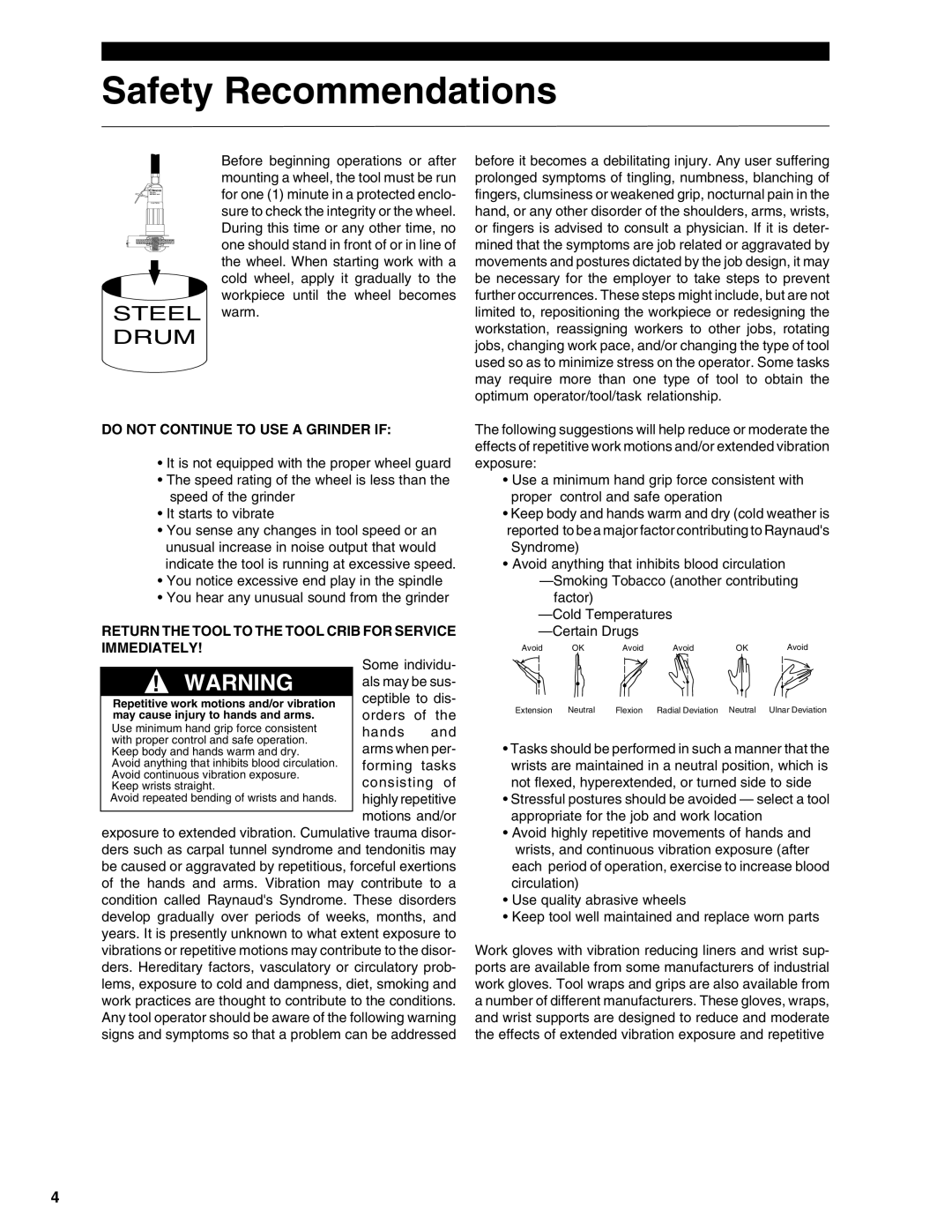
Safety Recommendations
Cleco
STEEL DRUM
Before beginning operations or after mounting a wheel, the tool must be run for one (1) minute in a protected enclo- sure to check the integrity or the wheel. During this time or any other time, no one should stand in front of or in line of the wheel. When starting work with a cold wheel, apply it gradually to the workpiece until the wheel becomes warm.
before it becomes a debilitating injury. Any user suffering prolonged symptoms of tingling, numbness, blanching of fingers, clumsiness or weakened grip, nocturnal pain in the hand, or any other disorder of the shoulders, arms, wrists, or fingers is advised to consult a physician. If it is deter- mined that the symptoms are job related or aggravated by movements and postures dictated by the job design, it may be necessary for the employer to take steps to prevent further occurrences. These steps might include, but are not limited to, repositioning the workpiece or redesigning the workstation, reassigning workers to other jobs, rotating jobs, changing work pace, and/or changing the type of tool used so as to minimize stress on the operator. Some tasks may require more than one type of tool to obtain the optimum operator/tool/task relationship.
DO NOT CONTINUE TO USE A GRINDER IF:
•It is not equipped with the proper wheel guard
•The speed rating of the wheel is less than the speed of the grinder
•It starts to vibrate
•You sense any changes in tool speed or an unusual increase in noise output that would indicate the tool is running at excessive speed.
•You notice excessive end play in the spindle
•You hear any unusual sound from the grinder
RETURN THE TOOL TO THE TOOL CRIB FOR SERVICE IMMEDIATELY!
Some individu-
!WARNING als may be sus-
ceptible to dis- orders of the
hands and arms when per- forming tasks consisting of highly repetitive motions and/or
exposure to extended vibration. Cumulative trauma disor- ders such as carpal tunnel syndrome and tendonitis may be caused or aggravated by repetitious, forceful exertions of the hands and arms. Vibration may contribute to a condition called Raynaud's Syndrome. These disorders develop gradually over periods of weeks, months, and years. It is presently unknown to what extent exposure to vibrations or repetitive motions may contribute to the disor- ders. Hereditary factors, vasculatory or circulatory prob- lems, exposure to cold and dampness, diet, smoking and work practices are thought to contribute to the conditions. Any tool operator should be aware of the following warning signs and symptoms so that a problem can be addressed
The following suggestions will help reduce or moderate the effects of repetitive work motions and/or extended vibration exposure:
•Use a minimum hand grip force consistent with proper control and safe operation
•Keep body and hands warm and dry (cold weather is reported to be a major factor contributing to Raynaud's Syndrome)
•Avoid anything that inhibits blood circulation
Avoid | OK | Avoid | Avoid | OK | Avoid |
Extension | Neutral | Flexion | Radial Deviation | Neutral | Ulnar Deviation |
•Tasks should be performed in such a manner that the wrists are maintained in a neutral position, which is not flexed, hyperextended, or turned side to side
•Stressful postures should be avoided — select a tool appropriate for the job and work location
•Avoid highly repetitive movements of hands and wrists, and continuous vibration exposure (after
each period of operation, exercise to increase blood circulation)
•Use quality abrasive wheels
•Keep tool well maintained and replace worn parts
Work gloves with vibration reducing liners and wrist sup- ports are available from some manufacturers of industrial work gloves. Tool wraps and grips are also available from a number of different manufacturers. These gloves, wraps, and wrist supports are designed to reduce and moderate the effects of extended vibration exposure and repetitive
4
